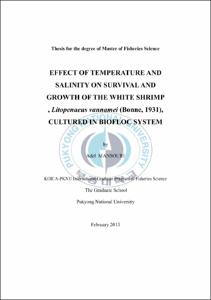EFFECT OF TEMPERATURE AND SALINITY ON SURVIVAL AND GROWTH OF THE WHITE SHRIMP , Litopenaeus vannamei (Bonne, 1931), CULTURED IN BIOFLOC SYSTEM
- Abstract
- The shrimp intensive culture industry provides huge revenues to most aquaculture producing countries, but it is also beset with problems that hamper its sustainability, due to the pressure it causes on the environment by the discharge of waste products, mainly toxic inorganic nitrogen species in the water bodies and by its dependence on expensive fish oil and fishmeal. Biofloc technology (BFT) systems offers a practical solution to both problems, water treatment is based upon developing and controlling heterotrophic bacteria within the culture component. Feed nutrients are recycled, doubling the utilization of protein and raising feed utilization.
Understanding the effect of factors such as dissolved oxygen concentration, temperature, salinity and choice of organic carbon source in bioflocculation formation and growth, also influence on juvenile shrimp survival and growth is essential for optimal practice. Molecular (real-time) PCR allow detecting specific bacteria species, evaluating the maturity and stability of the cooperative microbial community in biofloc technology system, experiments have been conducted to verify the effects of low salinity and temperature levels on survival and growth of juvenile shrimp Litopenaeus vannamei cultured for 40 days in no water exchange system. Bioflocs were prepared under laboratory condition in circular tank with diluted sea water .Commercial feed and wheat flour were given constantly as source of additional carbohydrates and water was vigorously aerated by aerator .After the preparation of bioflocs, juveniles shrimp (Litopenaeus vannamei) with (mean ± SD weight and length of 4.74±0.32g and 4.60±0.17 cm, respectively), were reared in eight 150L plastic tanks with a stocking density of 30 juvenile/Tank. Two culture treatments were applied (1) culture in the presence of bioflocs for different temperature levels of 34, 30, 28 and 26°C with same salinity (10psu); (2) culture in the presence of bioflocs for different low salinity levels of 5, 10,15 and 20psu with same temperature (30°C). In the first experiment, the juvenile at the lowest temperatures of 26°C and 28C showed the highest survival 76% and 72% compared to 42% at 30°C and 16% at 34°C. However, at all levels of temperature tested, specific growth rate gradually increased, reaching the maximum value at 34°C.The second experiment showed that temperature exerted a greater influence than the salinity on survival during the juvenile development. No significant difference (P<0.05) between treatments was found for salinity tolerance. Whereas, specific growth rate exhibited an increasing trend with increasing of salinity levels .Based on the survival and growth results, the best low salinity and temperature combination for the culture of Litopenaeus vannameiin biofloc technology system was 10 psu and 28°C (experiment 1) and 20 psu and 30°C (experiment 2). Finding of this experiments showed that temperature and salinity have effect on growth and survival of juvenile shrimp, also affect the quality and quantity of bacteria population present in biofloc system.
- Issued Date
- 2013
- Awarded Date
- 2013. 2
- Type
- Dissertation
- Publisher
- 부경대학교
- Affiliation
- 부경대학교 대학원
- Department
- 대학원 국제수산과학협동과정
- Advisor
- 김현우
- Table Of Contents
- LIST OF FIGURES iii
LIST OF TABLES iv
Abstract v
Introduction 1
Materials and methods 9
Animals 9
Preparation of bioflocs 10
Experimental design 11
1. Experiment 1 11
2. Experiment 2 12
Measurements of the physiochemical parameters 12
Biological measurements 14
3. Specific growth rate 14
4. Survival Rate 14
Periodic sampling 15
Molecular analysis 15
5. DNA extraction 15
6. Analysis of deduced amino acid sequences 17
Statistical analysis 17
Results 19
Experiment 1 (Temperature treatments) 19
7. Water Quality 19
8. Growth 20
9. Survival 21
Experement 2 (Salinity treatments) 21
10. Water Quality 21
11. Growth 22
12. Survival 22
Species-specific PCR results 23
Discussion 31
Conclusion 38
References 40
Acknowledgement 51
- Degree
- Master
- Appears in Collections:
- 글로벌수산대학원 > 국제수산과학협동과정
- Files in This Item:
-
-
Download
 EFFECT OF TEMPERATURE AND SALINITY ON SURVIVAL AND GROWTH OF THE WHITE SHRIMP , Litopenaeus vannamei.pdf
기타 데이터 / 552.64 kB / Adobe PDF
EFFECT OF TEMPERATURE AND SALINITY ON SURVIVAL AND GROWTH OF THE WHITE SHRIMP , Litopenaeus vannamei.pdf
기타 데이터 / 552.64 kB / Adobe PDF
-
Items in Repository are protected by copyright, with all rights reserved, unless otherwise indicated.